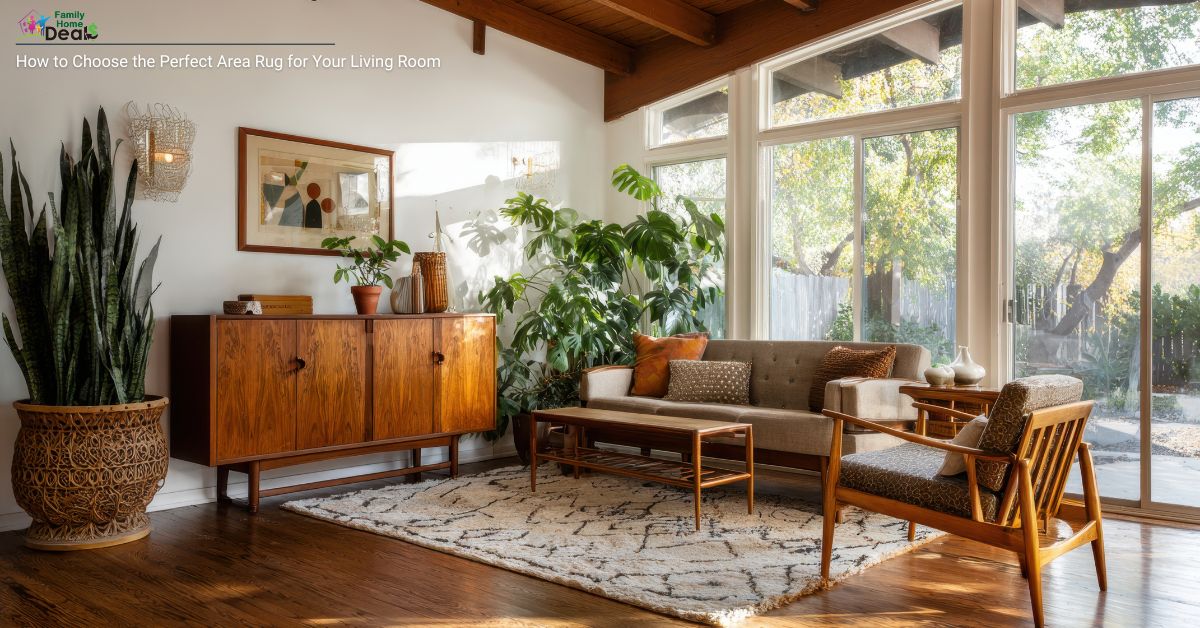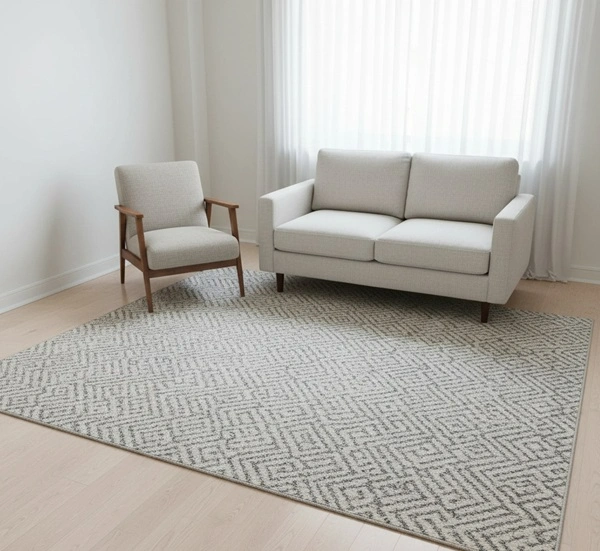
Choosing the right area rug for your living room might feel like a small decision — but it’s one of the most powerful ways to anchor the space, tie furniture together, and add warmth and personality. With so many sizes, materials, patterns, and placement options, it’s easy to get overwhelmed. Yet, when done right, the perfect rug transforms a room from cold and disconnected to cozy, cohesive, and intentional.
In this guide, we’ll walk through everything you need to know — from measuring and sizing to style, material, and placement — to make sure your rug complements your design goals and lifestyle. Whether you want your living room to feel minimalist and modern, bohemian and layered, or traditional and timeless, these expert-backed strategies will help you confidently choose an area rug that works beautifully for you.
Why the Right Area Rug for your Living Room Matters
Before diving into how to choose, it’s worth recognizing what a well-chosen rug really does:

-
Defines zones. In open-plan living areas, a rug helps delineate the seating area.
-
Anchors furniture. Placing the front legs of the seating on a rug creates visual unity and prevents a “floating” look.
-
Adds warmth & acoustics. A rug softens hard floors, absorbs sound, and makes the room more comfortable underfoot.
-
Reflects style. The rug is a design element — its color, pattern, and texture contribute significantly to the room’s character.
Step 1: Measure Your Space
1.1 Map Your Furniture Layout First
Your rug should serve your seating area, not necessarily the entire room. Designers recommend aligning your rug with how you actually arrange your sofa, chairs, and coffee table.
1.2 Use the “Perimeter Rule”
Leave a visible floor border around the rug’s edges to frame the rug and avoid a wall-to-wall carpet effect. Most experts suggest 6–18 inches between the rug edge and the wall. Homes & Gardens even recommends 12–18 inches.
1.3 The 70% Coverage Guideline
As another approach, aim for a rug that covers at least 70% of your living room floor. This guideline helps balance proportion with visual impact.
1.4 Mock It Out
Use painter’s tape or string to mark the dimensions of different rug sizes on your floor — for example, taping out 8′×10′ vs. 9′×12′ — to help you see what fits best.
Step 2: Choose the Right Size
This is one of the most common mistakes — picking a rug that’s too small.
Designer Guidelines for Size
-
For a standard living room, an 8′×10′ rug is often ideal.
-
In larger or open-plan spaces, consider 9′×12′ or more.
-
For very compact rooms, rugs in the 4′×6′ to 5′×8′ range may work, especially if only the front legs of furniture will sit on the rug.
Here is a quick reference table based on some rug-sizing guides:
| Furniture / Room Scale | Suggested Rug Size for Living Room* |
|---|---|
| Sofa up to 4′ | 5′ × 7′ or larger |
| Sofa up to 5′ | 6′ × 9′ or larger |
| Sofa up to 6′ | 7′ × 10′ or larger |
| Sofa up to 7′ | 8′ × 10′ or larger |
| Sofa up to 8′ | 9′ × 12′ or larger |
*These are general recommendations — your layout and design goals may shift them.
Pro Tip: If you’re between two sizes, go larger. Designers agree that an undersized rug is a more common mistake than one that’s slightly too big.
Step 3: Think About Placement
How you place the rug affects both its function and its visual impact.
Common Placement Styles
-
All Legs On
Place the entire sofa, chairs, and coffee table on the rug. This creates a fully grounded, cohesive look. -
Front Legs On
A classic designer move: have the front legs of your seating pieces on the rug, while the back legs remain off -
Floating Furniture
If your furniture is floating (not against the wall), center the rug under it with space around the edges. Leave about 6–12 inches of rug beyond the furniture’s front for balance.
Why Placement Matters
-
Anchoring creates a visual “island” that feels intentional and balanced.
-
Too small or misaligned rugs can make the furniture feel disconnected or “floating.”
-
In open-floor layouts, a correctly sized and placed rug helps define zones and maintain flow.
Step 4: Choose the Right Material
Your rug’s material affects not just how it looks, but how it feels, how it wears, and how easy it is to maintain.
Common Rug Materials & Their Pros
-
Wool
Durable, naturally stain-resistant, soft underfoot. A classic choice for living rooms. -
Cotton
Lightweight, breathable, more affordable, easy to clean, but less plush. -
Synthetic fibers (Nylon, Polypropylene, etc.)
Very durable, often stain-resistant, great for high-traffic areas or homes with pets/kids. -
Jute, Sisal, Natural Fibers
Textural and organic, good for casual or boho styles, but less forgiving on spills. -
Silk or High-End Blends
Luxurious and soft, but delicate and best in low-traffic zones.
Pile Height Considerations
-
Low Pile (flatweave or short fibers): Easier to clean, better for high-traffic or pet-friendly homes.
-
Medium Pile: Balances softness and durability.
-
High Pile / Shag: Very cozy, but harder to maintain, traps more dust.
Step 5: Decide on Color, Pattern & Style
Now comes the fun part: making your rug fit the personality of your living room.
Style & Design Considerations
-
Match or Contrast
-
Neutral base: Allows flexibility — choose a rug that either blends in (tonal neutrals) or adds a pop (bold, contrasting colors).
-
Bold statement: If your furniture is neutral, use a rug with a pattern or color as the focal point.
-
-
Pattern Scale
In smaller rooms, large or busy patterns can feel overwhelming. In bigger rooms, patterns can help fill the space and add visual interest. -
Lifestyle Reflection
-
If you want a cozy, layered, textural vibe → go for natural fibers or layered rugs.
-
For a polished, modern look → sleek, flatweave rugs with geometric patterns work well.
-
Example
Imagine you have a minimalist, Scandinavian-style living room with a light gray sofa, white walls, and pale wood floors. A flat-woven jute rug in natural tones could enhance the airy vibe. If you prefer a more dramatic contrast, a modern geometric rug with black-and-white or soft pastel lines could anchor the space without overwhelming the simplicity.

Step 6: Add Rug Pad — Don’t Skip It
A rug pad is a small investment with big benefits:
-
Prevents slipping and bunching.
-
Absorbs impact, reducing wear and tear.
-
Protects the floor underneath from scratches or discoloration.
-
Improves comfort and insulation.
Tip: Choose a pad slightly smaller (1–2 inches) than your rug all around.
Step 7: Maintenance & Care
To keep your area rug for the living room looking its best over time:
-
Vacuum regularly: For most rugs, once or twice a week helps.
-
Rotate seasonally: Flip or rotate the rug every few months so wear is even.
-
Spot clean spills immediately: Use mild detergent or a cleaner recommended for your rug material.
-
Deep clean carefully: Depending on the material, wool needs professional cleaning, and synthetics may go in a machine (check care label).
Common Mistakes to Avoid
-
Choosing a too-small rug. This is the most common design blunder — it fails to anchor the room.
-
Putting a rug flush against the wall. Skimping on perimeter space makes the room feel cramped.
-
Skipping the rug pad. Without it, your rug may shift, wear faster, or damage the floor.
-
Ignoring foot traffic patterns. If this area is a high-traffic zone, choose durable materials.
-
Overlooking scale. A rug that overpowers the room or competes with other patterns can disrupt harmony.
FAQs
Q: What if I have an odd-shaped living room?
A: Use painter’s tape to outline a few rug sizes; you can also layer rugs to create visual zones.
Q: Can I use more than one rug?
A: Yes — in very large or open-plan rooms, you can use a big central rug and smaller accent rugs for side seating, reading corners, or under coffee tables.
Q: How do I choose between a round rug vs. a rectangular one?
A: It depends on your furniture arrangement. Round rugs work well under circular coffee tables or in tight corners; rectangular rugs are more common and versatile for sofas and chairs.
Q: Do I need to buy a custom-size rug?
A: Not necessarily. Standard sizes (5′×8′, 8′×10′, 9′×12′) often work. Designers usually recommend these because they’re more available and easier to pair.
Real-Life Case Studies
Case Study 1: Small City Apartment
-
Space: 12′ × 14′ living room with a two-seater sofa and a lounge chair.
-
Challenge: Avoid a rug that feels too sparse or makes the rug look “floating.”
-
Solution: Use an 8′ × 10′ rug, place the front legs of the sofa and chair on it, and leave about 8 inches of floor space around the edges. Add a low-pile synthetic fiber rug for durability.

Case Study 2: Open-Plan Loft
-
Space: 20′ × 18′ combined living and dining area.
-
Challenge: Defining a seating zone without overwhelming the open space.
-
Solution: Choose a 9′ × 12′ rug that sits under the sofa, chairs, and coffee table. Leave a consistent border to frame the shape. Use a wool blend for softness, and pick a modern pattern that echoes the loft’s industrial-meets-minimal aesthetic.

How to Choose Based on Your Style Goals
Here’s how different design intentions change your rug-buying decisions:
| Design Goal | Rug Considerations |
|---|---|
| Scandinavian / Minimal | Natural materials (jute, wool), neutral colors, simple shapes |
| Bohemian / Eclectic | Layer rugs, mix textures, choose ethnic or geometric patterns |
| Modern / Contemporary | Clean lines, low pile, bold or abstract prints |
| Traditional / Classic | Oriental or Persian-inspired designs, rich colors, wool |
Final Tips Before Buying

-
Visualize first — Use painter’s tape or digital layout tools to mock your rug size in place.
-
Measure twice — Measure your furniture and space accurately.
-
Test the material — Request swatches if you can, especially for expensive rugs.
-
Invest in a good pad — As noted, it increases grip, comfort, and longevity.
-
Plan for maintenance — Cleaning and rotating will help your rug last.
Recommended Rugs to Consider
Here are a few area rugs that could work well in different living room styles:
-
TIPHEDE Flatwoven Rug (IKEA): Affordable and lightweight, great for minimalist or Scandinavian spaces.
-
LOHALS Rug Flatwoven (IKEA): Natural jute blend, ideal for organic, textured looks.
-
Brynlee Velvet Geometric Area Rug: Soft velvet feel and modern pattern — perfect for a cozy, chic living room.
-
Nordic Knots 6′×9′ Plush Rug: Luxuriously plush; great for a seating area that deserves a soft, rich underfoot feel.
-
Mark & Day Beauvais Woven Indoor Rug: Subtle woven texture and neutral tones, perfect for transitional or traditional-modern hybrids.
-
VÄNDPLATS Low Pile Rug (IKEA): Practical low pile, easy to clean, suitable for families or high foot traffic.
Conclusion
Choosing the right area rug for your living room is about more than picking something that looks nice — it’s about scale, placement, material, and how it complements your lifestyle and design vision. By carefully measuring your space, mocking up sizes, and anchoring your furniture on a properly sized rug, you create a grounded, intentional, and stylish layout. Then, select a material and style that match how you live and what aesthetic you want to express. Don’t forget: a rug pad can make a big difference in comfort and longevity.
As you shop, visualize the rug in your space, think about maintenance, and choose something that feels both beautiful and practical for your day-to-day. With the right approach, your rug won’t just be a floor covering — it will become the foundation of your room’s design, pulling everything together into a cohesive, inviting space.



